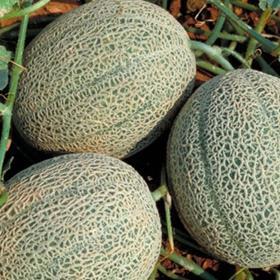
The birthday celebrated on 15 October 2009 in the southern Sicilian town of Gela was certainly a special one. Vegetable seed company Nunhems, which is present in some 40 countries worlwide, was there to mark the 25-year anniversary of its melon variety Fiola, taking the opportunity at the same time to run the rule over today’s melon market alongside some of the cultivar’s leading Sicilian producers.
The celebratory convention, moderated by noted agronomist and Fresh Point Magazine director Duccio Caccioni, began with an introductory speech by Ko Remijnse, managing director for marketing and sales at Nunhems, who explained how Fiola has been well accepted by various members of the melon supply chain. He commented: “It satisfies those who produce it because of the optimum performance obtained in the field and those who process it because it doesn’t create waste, but it also those who consume it thanks to its taste and sweetness.” Mr Caccioni echoed that sentiment: “Fiola is also a variety that has a future because it pleases consumers and producers alike. I know of no other product with that kind of longevity.”
It was then the turn of Nunhems crop sales manager Francisco Solera to remind delegates of the group’s major achievements in terms of varietal development within the melon category. “We are the most innovative company in melons and constantly introducing new varieties,” he said. Fiola, he explained, was launched in 1984 and characterised by long shelf-life, sweetness, taste and the fact it was easy to grow. It was followed in 1987 by Toledo – the first Piel de Sapo hybrid; in 1988 by Clipper and Topper – the first Charentais with long shelf-life, up to three weeks; and in 1992 by Ruidera – the first Piel de Sapo with a shelf-life of 90 days.
Two years later, he continued, Lunastar and Lunabel came along to offer the market a better-keeping Charentais; in 1996, Solarking and Solarnet emerged as the first Galia with four weeks’ shelf-life; and another two years after that the first Cantaloupe to be “truly appreciated” in northern European markets – Magenta, thanks to its dark colour – came along. More recently, Mr Solera observed, Nunhems has debuted Esmeralda and Estoril (2002), the first Galias with uniformally netted skin as demanded by the UK market; and Hidalgo (2005), the first mildew-resistant Piel de Sapo cultivar.
But according to Mr Solera, Fiola remains one of Nunhems’ most important varieties in terms of volume grown worldwide – with around 1,000ha currently in production, it is second only to Magenta, of which there is 2,000ha. He also gave delegates a brief overview of the situation in terms of global melon supply. “The world’s major producers are the Mediterranean countries, with Spain (20,000ha) in first place, followed by Italy (18,000ha) and France (15,000ha),” he noted. “Looking ahead, it is to be expected that Senegal, which so far has only 100ha of production, will soon overtake Central America in terms of supplying Europe. Central America alone currently stands at more than 16,000ha but 75 per per cent of that figure is for the US and 25 per cent for Europe. Attention should also be paid to Almería in Spain where, if they don’t manage to keep producing good quality, production will be replaced by Morocco and Senegal.”
Melons in the market
Following Mr Solera’s presentation, delegates heard from Pierangelo Mapelli, director of Sogemi, the company which manages Milan Wholesale Market. “These days, about 6,000 tonnes of Sicilian melons come to Milan each year, a volume which has to a large extent stabilised over the past few years,” Mr Mapelli revealed. “Prices for melons arriving in April are excellent: for Fiola, the rate is around E2.50 per kg. In May, it goes down to E1.50 per kg and in June to less than E1.00 per kg. We should produce more and better in the month of April, because Fiola achieves a great price during that period.”
Gianni Righi, former fresh produce manager at retail company Coop Italia, also contributed his view of the Italian market. “Today’s Italian consumer is paying more attention to price, but his or her expectations in terms of food safety – including compliance with production standards – and organoleptic quality remain,” he explained. “As a result, price, quality and service are the priorities for retailers, because they serve to attract the consumer. They are a necessary evil. Producers, for their part, must continue to maintain continuity of supply and consistent quality by selecting products according to grade and size; deliveries must be on time, quality requirements have to be met and the logistics must take care of the goods.”
Turning specifically to melons, Mr Righi reminded those present that in Italy they remain a seasonal product. “At the start of each campaign, therefore, we must convince the consumer all over again,” he said. “In that context, there could be some room for improvement on Fiola, so you should advertise in order to promote awareness of its qualities.”
Jean Paul Ginot, the scientist who originally selected Fiola, explained how the variety was the fruit of seven years’ work and more than 50 crosses. “Fortunately, the long storage times we were able to obtain for this melon was linked to a high grade of sugar, intense colour and consistent flesh,” he commented.
Drawing the conference to a close prior to a gala dinnner, Vittorio Messina, president of the Agrigento Chamber of Commerce, drew attention to the value of Nunhems’ work with Fiola in helping to boost the competitiveness of local melon producers. “This is the Sicily that works,” he said. “But let’s not forget the problems we face: doing business here is an heroic enterprise. We are not , however, a region that wants to be colonised. We want to grow together with people who are able to let us grow.”



